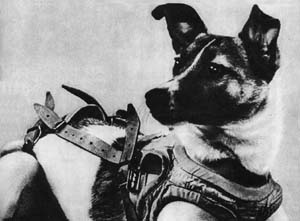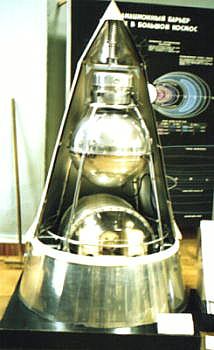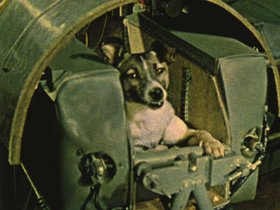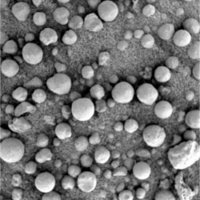 Laika, shown here in a harness, died from stress and overheating several
hours after being launched into space.
Laika, shown here in a harness, died from stress and overheating several
hours after being launched into space.|
From Wikipedia the free encyclopedia, by MultiMedia |
 Laika, shown here in a harness, died from stress and overheating several
hours after being launched into space.
Laika, shown here in a harness, died from stress and overheating several
hours after being launched into space.
Laika (from Russian: Лайка, "Barker") was one of the Russian space Dogs and the first living creature to enter orbit. She was launched into space on Sputnik 2, a Soviet spacecraft, on November 3, 1957. Like many other animals in space, she died during the mission, though earlier than intended.
She was found as a stray wandering the streets of Moscow, a mongrel female weighing approximately 6 kg (13 lb) and about 3 years old. "Laika" is in fact the Russian name for several breeds of Dogs similar to the husky. Her name was changed from Kudryavka (Russian for "Little Curly"), and she was also nicknamed Zhuchka ("Little Bug") and Limonchik ("Little Lemon"). The American press dubbed her Muttnik (mutt + suffix "-nik"). Her true ancestry can never be known, although it is generally accepted that she was part husky or other Nordic breed, and possibly part terrier.
Laika died a few hours after launch from stress and overheating. Her true cause of death was not made public until decades after the flight, with officials stating that she was either euthanized by poisoned food or died when the oxygen ran out. Russian officials have since expressed regret for allowing Laika to die.
Although Laika did not survive the trip, the experiment proved that a living passenger could survive being launched into orbit and endure weightlessness. It paved the way for human spaceflight, and provided scientists with some of the first data on how living organisms react to spaceflight environments.
 A model of Sputnik 2, Laika's space vehicle.
A model of Sputnik 2, Laika's space vehicle.
After the success of Sputnik 1, Nikita Khrushchev, the Soviet leader, wanted a second spacecraft launched on November 7, the 40th anniversary of the Bolshevik Revolution. There was a much more sophisticated satellite already under construction, but it would not be ready until December. This satellite would later become Sputnik 3.
In order to meet the November deadline, a new, less sophisticated design had to be built. According to Russian sources, the official decision to launch Sputnik 2 was made on October 10 or 12, leaving the team only 4 weeks to design and build the space craft. Sputnik 2, therefore, was something of a rushed job, with most elements of the space craft being constructed from rough sketches. Aside from the primary mission of sending a living passenger into space, Sputnik 2 also contained instrumentation for measuring solar radiation and cosmic rays.
After reaching orbit the nose cone was jettisoned successfully but the "Blok A" core did not separate as planned, preventing the thermal control system from operating correctly. Some of the thermal insulation also tore loose. Consequently, the temperature in the cabin rose to 40 °C (104°F).
The Soviet Union and the United States had previously sent animals only on sub-orbital flights. Three Dogs were trained for the Sputnik 2 flight: Albina, Mushka and Laika. Laika was selected and trained by the Russian space-life scientist Oleg Gazenko. Albina flew twice on a high-altitude test rocket while Mushka was used to test instrumentation and life support. To adapt the Dogs to the confines of the tiny cabin of Sputnik 2, they were kept in progressively smaller cages for periods up to 15 to 20 days. The extensive close confinement caused them to stop urinating or defecating, making them restless, and causing their general condition to deteriorate. Laxatives did not improve their condition, only long periods of training could. They were also placed in centrifuges that simulated the acceleration of a rocket launch and placed in simulators that simulated the noises of the spacecraft. This would cause their pulses to double and their blood pressure to increase by 30–65 torr. The Dogs were trained to eat a special high-nutrition gel that would be their food in space.
 Laika could stand or lie down in her padded space capsule.
Laika could stand or lie down in her padded space capsule.
According to a NASA document, Laika was placed in the satellite on October 31, 1957—three days before the start of the mission.[1] The temperatures at the launch site were extremely cold at that time of year, so a hose connected to an air conditioner was used to keep her container warm. Two assistants were assigned to keep a constant watch on Laika before launch. Just prior to launch on November 3, 1957 from Baikonur Cosmodrome, Laika's fur was sponged in a weak alcohol solution, and then carefully groomed. Iodine was painted onto areas where sensors would be placed to monitor her bodily functions.
The pressurized cabin on Sputnik 2 allowed enough room for her to lie down or stand and was padded. An air regeneration system provided oxygen, and a cooling fan was set to activate whenever cabin temperature exceeded 15°C. Food and water were dispensed in a gelatinised form. Laika was fitted with a harness, a bag to collect waste, and electrodes to monitor vital signs. The early telemetry indicated Laika was agitated but eating her food.
The sensors showed that during launch, her pulse rate rose to three times its resting level. After reaching weightlessness, her pulse rate decreased, but it took three times longer than it had during earlier ground tests, an indication of stress. Approximately five to seven hours into the flight, no further life signs were received from the spacecraft.
It had been planned that Laika would be euthanized with a poisoned serving of food after 10 days. For many years, the Soviet Union gave conflicting statements that she had either died from oxygen starvation when the batteries failed, or that she had been euthanized. There were many rumours circulated about the exact manner of her passing. In 1999, several Russian sources said that she died after four days when the cabin overheated. In October 2002, it was revealed by Dr. Dimitri Malashenkov, one of the scientists behind the Sputnik 2 mission, that Laika had died between five and seven hours after launch, from overheating and stress. According to a paper he presented to the World Space Congress in Houston, Texas, "It was practically impossible to create a reliable system of a temperature control in such small [sic] term".[2] Sputnik 2 was finally destroyed during reentry on April 14, 1958, after 2,570 orbits.
Sputnik 2 was not designed to be retrievable, so Laika was doomed to die from the beginning. It sparked a debate across the globe on the mistreatment of animals and animal testing to advance science. The mission was viewed by many, including some Soviet citizens, as a propaganda stunt.
In the United Kingdom, the National Canine Defence League called on all Dog owners to observe a minute's silence, while the Royal Society for the Prevention of Cruelty to Animals (RSPCA) received protests even before the Soviet Union had finished announcing the mission's success. Animal rights groups at the time called on members of the public to protest at Soviet embassies.
However, these protests were politically motivated, at least in part. In the Soviet Union, there was no controversy, as the Soviet people perceived exploits and personal sacrifices as normal and neither the media, nor books in the following years, nor the public questioned the decision to send the Dog into space to ultimately die. However, in 1998, Oleg Gazenko, one of the leading scientists responsible for sending Laika into space, did express regret for allowing her to die: "The more time passes, the more I am sorry about it. We did not learn enough from the mission to justify the death of the Dog." [3]
 NASA named this soil target on Mars after Laika during the
Mars Exploration Rover mission
NASA named this soil target on Mars after Laika during the
Mars Exploration Rover mission
Laika's pioneering journey made her one of the most famous Dogs in the world. A plaque commemorating fallen cosmonauts was unveiled at the Institute for Aviation and Space Medicine in Star City, Moscow in November 1997, and in one corner of the plaque there is an image of Laika. She has been pictured on several postage stamps in different countries around the world. Brands of chocolate and cigarettes were named in her honour as well as a large collection of memorabilia that continues to be sold at auctions today.
On March 9, 2005 a patch of soil on Mars was unofficially named "Laika" by mission controllers, it is located near Vostok Crater in Meridiani Planum. It was examined by the Mars Exploration Rover Opportunity's microscopic imager on Sol 400.
Literature
Sputnik Sweetheart by Haruki Murakami references Laika both in the title and
several times throughout the novel.
Star Wreck 7: The Fido Frontier by Leah Rowlinski is a Star Trek parody in which
it is discovered that Laika survived and made alien allies.
The Doctor Who novel Alien Bodies by Lawrence Miles tells of Laika's funeral on
the planet Quiescia.
The novel Habitus by James Flint features Laika as one of its protagonists,
based on the premise that she survives and continues to orbit the earth, having
learned to draw sustenance from the world's radio transmissions.
The novel Intervention by Julian May mentions Laika's rescue by a sympathetic
alien race called the Simbiari.
Music
Domenico Modugno's Volare - later remade by the Gipsy Kings, among other
bands - is centered around Laika's exploits.
A number of bands have taken inspiration from Laika for their names, including
Laika Dog, Laika and the Cosmonauts and the eponymous Laika, whose four albums
all feature the canine cosmonaut in their cover art.
The Spanish pop group Mecano wrote a biographical song titled "Laika" on their
1987 album Descanso Dominical.
The band Moxy Früvous wrote a song titled "Laika" on their 1993 album
Bargainville.
The Swedish band The Cardigans included a song titled "Laika" on their 1994 EP
Sick and Tired.
Another Swedish band, Blipp!, has a song called "Laika" on their 2005 album
Impulser.
The 1996 CCCP release "Cosmos," an album of mostly paeans to the Soviet space
program, featured the song "Laika Laika," complete with Russian military men's
chorus.
The Japanese singer Akino Arai wrote a song called "Sputnik" on her 2000 album "Furu
Platinum" (Raining Platinum) about Laika. The song also seems to confuse Laika
with Kloka, a Russian space Dog that was invented by the Spanish artist Joan
Fontcuberta.
The Reggae dub group Spacemonkeyz in 2002 released an album entitled Laika Come
Home, an album of remixes of the music performed by Damon Albarn's Gorillaz.
Norwegian singer/songwriter Åge Aleksandersen released the album Laika in 1991,
with the Dog being remembered in the title track. The album flopped.
The Divine Comedy's 2004 album Absent Friends mourns Laika in the title track,
and features an instrumental "Laika's Theme".
The Arcade Fire wrote a song called "Neighbourhood #2 (Laika)" on their debut
LP, Funeral, in 2004.
Laika and the Cosmonauts is a Finnish pop band that has gained some national
fame.
The band Polaris dedicated their album Music from the Adventures of Pete & Pete
to Laika and Ham the Chimp.
Cinema and TV
In the 1985 Swedish film My Life as a Dog (Mitt liv som hund) [4], the
protagonist - a contemporary boy who feels powerless over his own fate -
poignantly compares himself to Laika. The movie was nominated for an Academy
Award for Writing Adapted Screenplay in 1989.
The Lost In Space episode One of our Dogs is Missing involves a Dog coming out
of a crashed spaceship; Judy confirms with Maureen that early ships did take up
Dogs (not mentioning Laika by name), but the origin of this Dog is almost as
unbelievable as the fact that it never appeared after the episode.
References